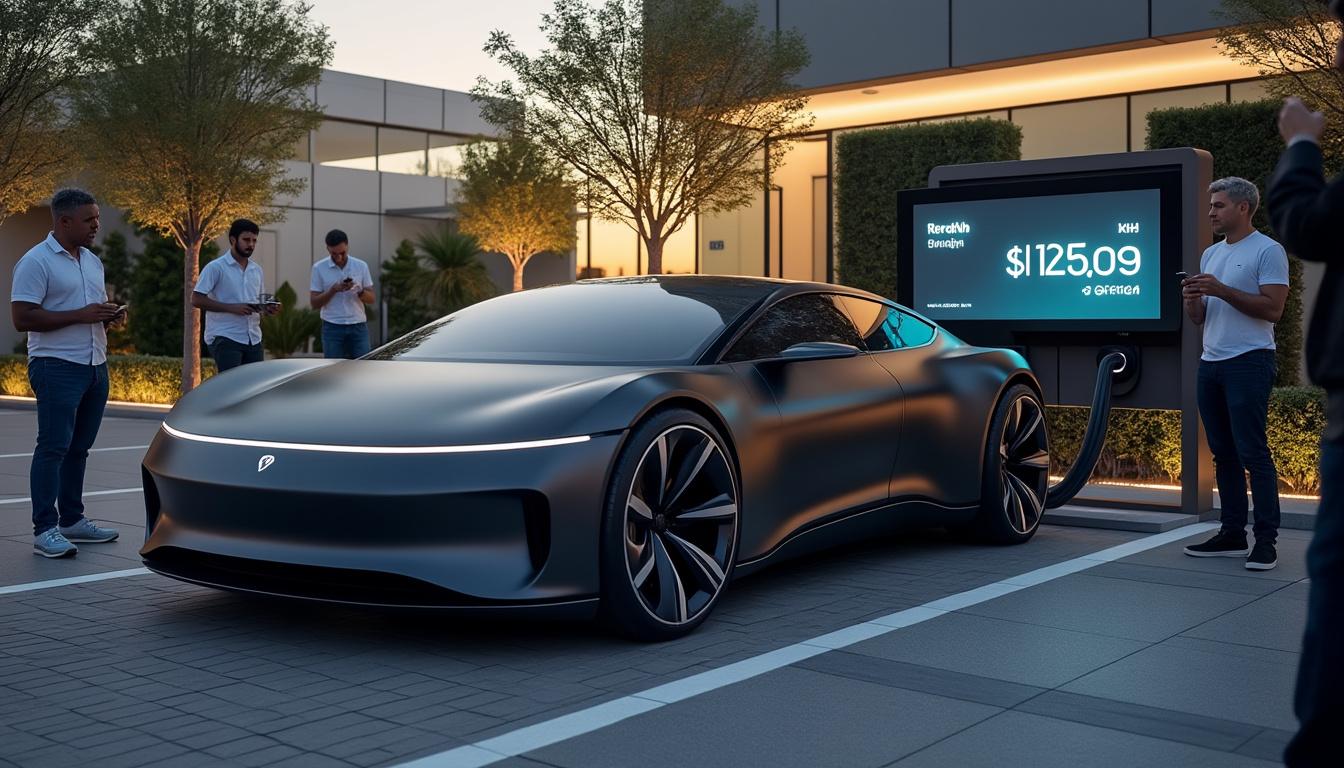The new legal framework for electric mobility promises to simplify charging, reduce costs, and accelerate permits, in direct alignment with the European regulation on alternative fuels infrastructure. It is a concrete opportunity to make the transition faster, fairer, and more efficient for drivers, investors, and city planners.
| Short on time? Here’s the gist: | |
|---|---|
| 🔎 Point | 📌 Summary |
| ✅ Key Point #1 | Simplification of licensing: tacit support, less bureaucracy, ex-post control to speed up the installation of charging points ⚡ |
| ✅ Key Point #2 | Lower and clearer prices: elimination of the intermediary “electric mobility marketer” and clear tariffs by kWh 💶 |
| ✅ Key Point #3 | Best practices: use 100% renewable energy to generate individual carbon credits and reduce your footprint 🌱 |
| ✅ Bonus | Alignment with the European AFIR regulation: universal access, interoperability, and real-time information for all users 🗺️ |
New regulatory framework in electric mobility: what changes in charging and how this benefits you
When a regime cuts costs, simplifies rules, and maintains smart oversight, everyone benefits. The new framework announced by Jean Barroca focuses on three areas of direct impact: simpler charging, fairer prices, and faster permits, without compromising on safety and quality. The connection to energy is total: transportation accounts for about 30% of national emissions, and the National Energy and Climate Plan aims for -55% emissions by 2030, with 51% renewables in final consumption. To get there, charging needs to be as easy as plugging in a household appliance.
The most visible element for you is the elimination of the “electric mobility marketer”, an intermediary that, in practice, complicated the bill and increased the service cost. With its removal, the sector tends to operate with more direct relationships between the station operator and the user, cutting redundant costs and clarifying who does what. Add to this the principle of “tacit support” in licensing: fewer papers upfront, more auditing afterwards. The rule aligns with Europe and the AFIR regulation, which requires universal access, public data, and easy integration between networks.
Agile licensing and ex-post oversight
Installing a charging point in a condominium, local business, or public park will now follow a logic of “approve to advance, verify rigorously later.” The goal is to increase the density of points and reduce downtime. A practical example: a small supermarket that wants two AC chargers of 22 kW can plan construction and operation in weeks instead of months, provided it meets technical, safety, and accessibility requirements.
For you, this translates into less detours, fewer queues, and a higher likelihood of finding available charging daily. And when the network grows, competition also increases—an essential condition for improving experience and reducing prices.
- ⚡ Faster installation: projects come to life in less time.
- 🧾 Readable tariffs: clear price per kWh, with no surprises.
- 🧭 More points on the map: coverage increases, relieving pressure zones.
- 🔒 Guaranteed quality: strengthened inspections and audits after operation starts.
| 🛠️ Change | 🎯 Practical impact | 👥 For whom | 📅 Horizon |
|---|---|---|---|
| Elimination of the intermediary | Less costs on the bill and simpler contracts | Drivers and small operators | To take effect as the final law comes into force |
| Tacit support in licensing | Works start earlier, oversight afterwards | Municipalities, condominiums, businesses | Progressive application |
| Alignment with AFIR | Interoperability and public data | Users and ERSE | In convergence with the EU |
| Transparent pricing 💶 | Comparing prices becomes easy and quick | Families and fleets | Immediate after publication |
Realistic example to inspire decisions
Imagine a condominium with 40 units in Aveiro. With the new rule, the assembly approves the pre-wiring of the garage, and an operator installs eight scalable AC points for 24. The simplified licensing allows starting in four weeks, amortizing the investment with rotating use. Result: more neighbors adopt electric vehicles, and you no longer depend on the only public station in the neighborhood.
Prices, carbon credits, and user experience: how the new regime cuts costs and rewards good choices
Price and simplicity go hand in hand. By removing the intermediary that mainly charged fees, space opens up for more direct pricing structures and offers that reward off-peak charging, 100% renewable energy, and transparent loyalty. For you, the equation is clear: pay less per kWh and know in advance how much you will spend per trip.
An ambitious point of the new regime is to allow the issuance of individual carbon credits when charging occurs with wholly green electricity. This turns your energy choice into a measurable asset, with potential appreciation in voluntary compensation schemes. Imagine fueling your vehicle with solar energy from a local cooperative and, at the end of the month, receiving a statement detailing the emissions avoided and the corresponding credit. It’s incentive, it’s education, and it’s a market in favor of the climate.
How to save without losing quality
With operators competing more openly, packages emerge that adapt to your driving patterns. Urban fleets value flat-rate contracts during off-peak hours; families choose price per kWh with loyalty discounts; frequent travelers look for networks with good availability on highways and “plug & charge.”
- 💡 Charge off-peak: nighttime tariffs reduce the cost per kWh.
- 🌿 Choose 100% renewable: access individual carbon credits.
- 📱 Use interoperable apps: compare prices in real time and avoid surprises.
- 🧩 Combine AC at home and DC on the go: the perfect balance between cost and speed.
| 📊 Before | 🚀 After | 💸 Your difference | 🔗 Notes |
|---|---|---|---|
| The intermediary added margins | Direct operator-user relationship | Final tariff tends to go down | Healthier competition |
| Poorly readable bill | Price per kWh + session fee clear | Simple comparison between networks | Better purchasing decision |
| Green charging without recognition | Individual carbon credits 🌱 | Values sustainable habits | Useful for personal reporting |
| Complex roaming | AFIR interoperability 💫 | Fewer cards, more fluidity | European regulation |
Notice how the combination of simplification and transparency pulls the average price down while creating value with carbon credits. For many residential users, the golden rule will continue to be charging slowly and cheaply at home, reserving fast DC for long trips. Urban fleets, in turn, will benefit from agreements in private parks with certified renewable energy, converting each green kWh into competitive and reputational advantage.

European standard infrastructure: AFIR, universal access, and open data serving the user
A reliable network is not just made of cables and chargers; it needs standards, open data, and interoperability. The alignment with the European AFIR regulation (often referred to as AFFIR in public discussions) establishes coverage requirements, minimum power, universal payment methods, and real-time information. For you, this means knowing where to charge, how much you will pay, and the likelihood of the station being functional when you arrive.
In practice, AFIR requires stations in strategic corridors, with consolidated powers and payment by card available without prior subscription. Applications will now display prices per kWh, occupancy status, and estimated waiting time. Small municipalities, often overlooked, gain relevance by integrating into regional networks, benefiting from tourism, logistics, and the internalization of electric mobility.
Open data and integration into apps you already use
The new regime prioritizes the availability of data via reliable public APIs. This openness allows navigation, mapping, and fleet management applications to aggregate information from multiple operators, preventing you from having to install five apps to make a trip. With AFIR, the national network becomes, literally, readable for you and any digital service.
- 🗺️ Updated maps: location, power, and availability in real time.
- 💳 Universal payment: physical or digital card at any station.
- ♿ Accessibility: spaces designed for all users.
- 🔧 Monitored reliability: public metrics of uptime.
| 🧭 AFIR Requirement | 🏗️ On the ground | 🎁 Direct benefit | ⌛ Typical deadline |
|---|---|---|---|
| Corridors with minimum power | DC hubs on key highways | Predictable long journeys | Phased implementation |
| Payment without subscription 💳 | TPE/contactless at all stations | Zero friction for visitors | Regulatory requirement |
| Public data 🔍 | Open APIs with SLAs | Reliable and comparable apps | Continuously evolving |
| Accessibility and signage ♿ | Standardized parking and ramps | Safe usage for all | National guidelines |
For municipalities and local businesses, the lesson is clear: integrating into the digital and physical ecosystem is the best way to attract users. By guaranteeing quality data, your station appears first in searches, the occupancy rate improves, and the return on investment accelerates. And for you, the driver, the experience becomes predictable, without “guessing games” at each charging point.
From garage to street: integrating electric vehicles with renewable energy, biomethane, and green hydrogen
The energy transition goes beyond the car. The new regulatory framework engages with the advancement of renewables and the need to develop sectors like biomethane and green hydrogen, mentioned as critical for decarbonizing hard-to-abate sectors. At home, the integration of photovoltaics, heat pumps, and electric vehicles creates an efficient ecosystem. On the street, these solutions interact with public networks and buses or trucks that may sometimes achieve better results with renewable gas or H2.
For you, an attentive resident, the winning strategy involves combining residential charging in off-peak hours with local solar energy, storing when it makes sense, and activating bidirectional charging (V2H/V2G) as vehicles and regulations enable. The direct consequence is lower energy bills and an ever-decreasing environmental footprint, with the possibility to monetize flexibility when the grid needs it.
Three residential scenarios that work
Consider three profiles: an apartment with a garage space and pre-wiring; a house with 6 kW of photovoltaics and a battery; and a cooperative building with an energy micro-community. In all, the new regime helps simplify the installation of the point, enable clear contracts, and align data for smart consumption management.
- 🏡 Nighttime AC + daytime solar: the classic that reduces costs and emissions.
- 🔁 Progressive V2H/V2G: the car as a “battery” for home and grid.
- 🧮 Carbon credits: account for and value what you avoid emitting.
- 🤝 Energy communities: local sharing improves returns.
| 🏠 Scenario | ⚡ Strategy | 💰 Typical outcome | 🌍 Impact |
|---|---|---|---|
| Apartment with pre-wiring | Charge at night on AC 7.4–11 kW | Predictable and low bill | Fewer peaks on the grid |
| House + PV + battery ☀️ | Solar for the car, grid as backup | Significant annual savings | Almost zero emissions |
| Cooperative with sharing 🤝 | Collective management of the load | Optimized tariffs | Shared carbon credits |
And where do biomethane and hydrogen fit in? In heavy mobility, logistics, and public transport with high demand, these renewable solutions can complement battery electric vehicles. Portugal has room to transform waste into assets, converting biogas into biomethane for fleets and preparing H2 green refueling corridors where it makes sense. The message is simple: different technologies, each in the right context—and all aligned to the common climate goal.
Public transport, cities, and regulatory sandboxes: where acceleration brings greater return
Cities concentrate people, emissions, and opportunities for change. The new regime proposes flexible regulation through regulatory sandboxes, controlled testing spaces that allow for the trial of innovation in bus routes, urban logistics, and sharing systems, adjusting rules based on evidence. This is where theory turns into practice, with pilots measuring emission reductions, user satisfaction, operational costs, and air quality.
Why does this matter to you? Because what works in a well-designed sandbox becomes scalable public policy. If a city proves that replacing 30% of its fleet with electric vehicles reduces total costs over five years and also improves punctuality, the benefit reaches your monthly pass and your health. And with faster permits for charging hubs, transport companies have fewer stops due to lack of infrastructure.
How to structure pilots that achieve results
A good pilot starts with clear metrics and ends with open data for public scrutiny. Use reliability targets above 97%, monitor consumption and availability in real time, and involve universities and startups to accelerate the learning curve. From there, replicating and adapting becomes simple.
- 🚌 Priority routes: corridors with high impact on emissions and noise.
- 🔌 Smart charging depots: algorithms that reduce peaks.
- 📈 Public metrics: uptime, cost per km, CO₂ avoided.
- 🏛️ Partnerships: municipality + operators + academia + regulator.
| 🧪 Sandbox element | 🎯 Goal | 🧰 Tools | 📣 Expected outcome |
|---|---|---|---|
| Electric fleet pilot | Reduce OPEX and emissions | Telemetry + smart charging | Lower cost/km and more reliability |
| Last mile logistics 📦 | Decarbonize urban deliveries | Microhubs + e-vans + data | Less traffic and local pollution |
| Tariff integration 💳 | Facilitate payment | Contactless + single app | Faster adoption |
| Independent assessment 🔍 | Transparency and adjustment | Public reporting | Scale with legitimacy |
For municipalities and operators, the gain comes from pragmatism: small tests, quick measurement, immediate adjustment, safely expand. For you, the user, the result appears in more silence on the streets, cleaner air, and more reliable public services—benefits that you feel in daily life, not just in statistics.
If you want to start now: choose an interoperable card or app, check which nearby stations use 100% renewable energy, and plan at least one off-peak charging this week. Small decisions, repeated consistently, add up to the structural change that the new regulatory framework makes possible.
Source: www.dn.pt


